Flora and fauna
Vegetation
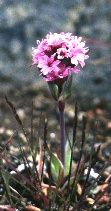 The harsh climatic
conditions, combined with the gravelly nature of the sparse soil (lack
of chemical weathering), which leads to rapid run-off, results in desert-like
conditions. That the paucity of vegetation is connected with lack of water
is evident from the relatively luxuriant patches of willow (Salix
sp.), crowberry (Empetrum nigrum) and numerous flowers such as Arnica,
Campanula, Gentiana, Viscaria, Chamaenerion and Oxyria that
can be found beneath melting snow patches on slopes. The entire coastline
from Scoresbysund to Ammasalik is unusually poor in vegetation in comparison
to areas both to the north and the south, because of the narrowness of
the ice-free land and the proximity of abundant drift ice and its associated
fogs.
The harsh climatic
conditions, combined with the gravelly nature of the sparse soil (lack
of chemical weathering), which leads to rapid run-off, results in desert-like
conditions. That the paucity of vegetation is connected with lack of water
is evident from the relatively luxuriant patches of willow (Salix
sp.), crowberry (Empetrum nigrum) and numerous flowers such as Arnica,
Campanula, Gentiana, Viscaria, Chamaenerion and Oxyria that
can be found beneath melting snow patches on slopes. The entire coastline
from Scoresbysund to Ammasalik is unusually poor in vegetation in comparison
to areas both to the north and the south, because of the narrowness of
the ice-free land and the proximity of abundant drift ice and its associated
fogs.
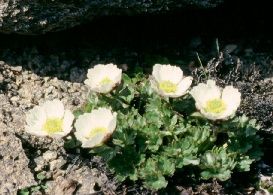 Another
factor very important to the distribution of plants is the aspect. Thus
south-facing slopes are snow-free in summer and, when watered, become vegetated.
North-facing slopes are usually covered with permanent snow and ice. This
situation is clearly seen on either side of Forbindelsesgletscher, where
the south-facing Pukugaqryggen ("Crowberry Ridge") has many green willows
and crowberries clinging to the rocks, the other side is largely snow-covered.
This factor is well-known to the Inuit, whose language makes a clear distinction
between the sunny and shaded sides ("sarqaq" and "alangoq", respectively).
Another
factor very important to the distribution of plants is the aspect. Thus
south-facing slopes are snow-free in summer and, when watered, become vegetated.
North-facing slopes are usually covered with permanent snow and ice. This
situation is clearly seen on either side of Forbindelsesgletscher, where
the south-facing Pukugaqryggen ("Crowberry Ridge") has many green willows
and crowberries clinging to the rocks, the other side is largely snow-covered.
This factor is well-known to the Inuit, whose language makes a clear distinction
between the sunny and shaded sides ("sarqaq" and "alangoq", respectively).
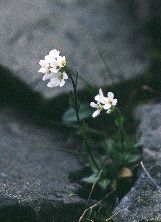 This is but
one example of the local effects which are important to climate here. Another
is the degree of exposure to cold fjord winds with their accompanying fogs,
and, as noted above, vegetation - especially flowering plants - is noticeably
sparser at sea level, where these conditions are frequent. The inner parts
of the fjord also differ from Skærgård in having a more continental
or high Arctic climate. Precipitation is much lower and fogs are absent
(except in rainy periods). On suitable slopes (i.e. south-facing) vegetation
is relatively abundant with characteristic high Arctic plants such as Arctic
poppy (Papaver radicatum) and the heather (Cassiope tetragona), which are
absent or sporadic on the coast.
This is but
one example of the local effects which are important to climate here. Another
is the degree of exposure to cold fjord winds with their accompanying fogs,
and, as noted above, vegetation - especially flowering plants - is noticeably
sparser at sea level, where these conditions are frequent. The inner parts
of the fjord also differ from Skærgård in having a more continental
or high Arctic climate. Precipitation is much lower and fogs are absent
(except in rainy periods). On suitable slopes (i.e. south-facing) vegetation
is relatively abundant with characteristic high Arctic plants such as Arctic
poppy (Papaver radicatum) and the heather (Cassiope tetragona), which are
absent or sporadic on the coast.
Fauna
The only land animals around Skærgård are a few Arctic foxes
and occasional bears. However, in 1972, the Westminster School expedition
recovered a reindeer antler from the Frederiksborg Glacier and, in 1991,
Dennis Bird and Bob Gannicott found a reindeer skeleton with hair on Hutchinson
Plateau. Thus, other animals have been present in times gone by. Birds
include several types of gulls, guillemots, eider duck, geese, ravens,
divers (loons), ptarmigan, small waders and land birds (such as the snow
bunting), the occasional Greenland falcon and possibly a rare snowy owl.
Although some of these birds are occasionally eaten, they tend to be ignored
unless seals fail.
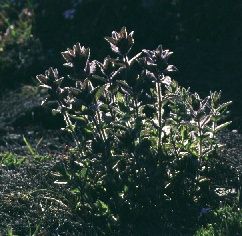 The
sea, however, is rich in mammals: the fjord or ringed seal, the bearded
seal, the bladdernosed seal, the Greenland seal and the occasional walrus
along with whales. Whales include large baleen whales, which I have not
been able to identify, and toothed whales including the killer whale and
most importantly numerous narwhals, which migrate into Kangerlussuaq in
the summer and are an important quarry for Inuit hunters. Seals and narwhals
are the primary quarry of the Inuit hunter.
The
sea, however, is rich in mammals: the fjord or ringed seal, the bearded
seal, the bladdernosed seal, the Greenland seal and the occasional walrus
along with whales. Whales include large baleen whales, which I have not
been able to identify, and toothed whales including the killer whale and
most importantly numerous narwhals, which migrate into Kangerlussuaq in
the summer and are an important quarry for Inuit hunters. Seals and narwhals
are the primary quarry of the Inuit hunter.
Fish are sparse in the waters of the fjord and are limited to species
such as polar cod or "uvaq" (Gradus ogae), sculpin (several species) and
capelin or "ammassat" although these last do not seem to form dense shoals
as they do further south. A small population of Arctic char (Salvelinus
alpinus) occurs in Vandfaldsdalen and Sødalen (Miki Fjord). None
of these fish are of any importance in the local economy.
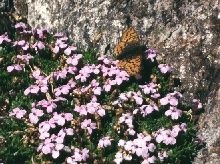 The most esteemed
quarry from the hunters point of view is the polar bear, both from the
prestige which is accrued by successful hunters and from the value of
its meat and skin. In common with other Inuit communities, numerous traditions
are connected with the hunting of bears and the distribution of parts of
the animal. Numbers of bears seem to swing greatly, perhaps depending on
the intensity of hunting. Whereas in 1986-87 about 50 were caught after
a period of three years without hunting, in 1987-1988 this number fell
to 14. As the number killed in 1935-36 was 28 (3 hunters) and in 1990-91
it was 22 with a similar number of hunters, the numbers do not seem to
have fallen drastically. While no geologist has yet been attacked by a
bear, there are at least two occasions when inquisitive animals have proved
troublesome and it is advisable to be prepared for this eventuality.
The most esteemed
quarry from the hunters point of view is the polar bear, both from the
prestige which is accrued by successful hunters and from the value of
its meat and skin. In common with other Inuit communities, numerous traditions
are connected with the hunting of bears and the distribution of parts of
the animal. Numbers of bears seem to swing greatly, perhaps depending on
the intensity of hunting. Whereas in 1986-87 about 50 were caught after
a period of three years without hunting, in 1987-1988 this number fell
to 14. As the number killed in 1935-36 was 28 (3 hunters) and in 1990-91
it was 22 with a similar number of hunters, the numbers do not seem to
have fallen drastically. While no geologist has yet been attacked by a
bear, there are at least two occasions when inquisitive animals have proved
troublesome and it is advisable to be prepared for this eventuality.
A great blessing of the Skærgård area, resulting from the
uniformly low temperatures and almost constant winds, is that mosquitoes
are virtually non-existent, in contrast to the sheltered, well vegetated
valleys of Ammassalik to the south and the fjord country beyond Scoresbysund
to the north, where they can be unbearable.
© 2003 skaergaard.org
 Another
factor very important to the distribution of plants is the aspect. Thus
south-facing slopes are snow-free in summer and, when watered, become vegetated.
North-facing slopes are usually covered with permanent snow and ice. This
situation is clearly seen on either side of Forbindelsesgletscher, where
the south-facing Pukugaqryggen ("Crowberry Ridge") has many green willows
and crowberries clinging to the rocks, the other side is largely snow-covered.
This factor is well-known to the Inuit, whose language makes a clear distinction
between the sunny and shaded sides ("sarqaq" and "alangoq", respectively).
Another
factor very important to the distribution of plants is the aspect. Thus
south-facing slopes are snow-free in summer and, when watered, become vegetated.
North-facing slopes are usually covered with permanent snow and ice. This
situation is clearly seen on either side of Forbindelsesgletscher, where
the south-facing Pukugaqryggen ("Crowberry Ridge") has many green willows
and crowberries clinging to the rocks, the other side is largely snow-covered.
This factor is well-known to the Inuit, whose language makes a clear distinction
between the sunny and shaded sides ("sarqaq" and "alangoq", respectively).
 The harsh climatic
conditions, combined with the gravelly nature of the sparse soil (lack
of chemical weathering), which leads to rapid run-off, results in desert-like
conditions. That the paucity of vegetation is connected with lack of water
is evident from the relatively luxuriant patches of willow (Salix
sp.), crowberry (Empetrum nigrum) and numerous flowers such as Arnica,
Campanula, Gentiana, Viscaria, Chamaenerion and Oxyria that
can be found beneath melting snow patches on slopes. The entire coastline
from Scoresbysund to Ammasalik is unusually poor in vegetation in comparison
to areas both to the north and the south, because of the narrowness of
the ice-free land and the proximity of abundant drift ice and its associated
fogs.
The harsh climatic
conditions, combined with the gravelly nature of the sparse soil (lack
of chemical weathering), which leads to rapid run-off, results in desert-like
conditions. That the paucity of vegetation is connected with lack of water
is evident from the relatively luxuriant patches of willow (Salix
sp.), crowberry (Empetrum nigrum) and numerous flowers such as Arnica,
Campanula, Gentiana, Viscaria, Chamaenerion and Oxyria that
can be found beneath melting snow patches on slopes. The entire coastline
from Scoresbysund to Ammasalik is unusually poor in vegetation in comparison
to areas both to the north and the south, because of the narrowness of
the ice-free land and the proximity of abundant drift ice and its associated
fogs.
 This is but
one example of the local effects which are important to climate here. Another
is the degree of exposure to cold fjord winds with their accompanying fogs,
and, as noted above, vegetation - especially flowering plants - is noticeably
sparser at sea level, where these conditions are frequent. The inner parts
of the fjord also differ from Skærgård in having a more continental
or high Arctic climate. Precipitation is much lower and fogs are absent
(except in rainy periods). On suitable slopes (i.e. south-facing) vegetation
is relatively abundant with characteristic high Arctic plants such as Arctic
poppy (Papaver radicatum) and the heather (Cassiope tetragona), which are
absent or sporadic on the coast.
This is but
one example of the local effects which are important to climate here. Another
is the degree of exposure to cold fjord winds with their accompanying fogs,
and, as noted above, vegetation - especially flowering plants - is noticeably
sparser at sea level, where these conditions are frequent. The inner parts
of the fjord also differ from Skærgård in having a more continental
or high Arctic climate. Precipitation is much lower and fogs are absent
(except in rainy periods). On suitable slopes (i.e. south-facing) vegetation
is relatively abundant with characteristic high Arctic plants such as Arctic
poppy (Papaver radicatum) and the heather (Cassiope tetragona), which are
absent or sporadic on the coast.
 The
sea, however, is rich in mammals: the fjord or ringed seal, the bearded
seal, the bladdernosed seal, the Greenland seal and the occasional walrus
along with whales. Whales include large baleen whales, which I have not
been able to identify, and toothed whales including the killer whale and
most importantly numerous narwhals, which migrate into Kangerlussuaq in
the summer and are an important quarry for Inuit hunters. Seals and narwhals
are the primary quarry of the Inuit hunter.
The
sea, however, is rich in mammals: the fjord or ringed seal, the bearded
seal, the bladdernosed seal, the Greenland seal and the occasional walrus
along with whales. Whales include large baleen whales, which I have not
been able to identify, and toothed whales including the killer whale and
most importantly numerous narwhals, which migrate into Kangerlussuaq in
the summer and are an important quarry for Inuit hunters. Seals and narwhals
are the primary quarry of the Inuit hunter.
 The most esteemed
quarry from the hunters point of view is the polar bear, both from the
prestige which is accrued by successful hunters and from the value of
its meat and skin. In common with other Inuit communities, numerous traditions
are connected with the hunting of bears and the distribution of parts of
the animal. Numbers of bears seem to swing greatly, perhaps depending on
the intensity of hunting. Whereas in 1986-87 about 50 were caught after
a period of three years without hunting, in 1987-1988 this number fell
to 14. As the number killed in 1935-36 was 28 (3 hunters) and in 1990-91
it was 22 with a similar number of hunters, the numbers do not seem to
have fallen drastically. While no geologist has yet been attacked by a
bear, there are at least two occasions when inquisitive animals have proved
troublesome and it is advisable to be prepared for this eventuality.
The most esteemed
quarry from the hunters point of view is the polar bear, both from the
prestige which is accrued by successful hunters and from the value of
its meat and skin. In common with other Inuit communities, numerous traditions
are connected with the hunting of bears and the distribution of parts of
the animal. Numbers of bears seem to swing greatly, perhaps depending on
the intensity of hunting. Whereas in 1986-87 about 50 were caught after
a period of three years without hunting, in 1987-1988 this number fell
to 14. As the number killed in 1935-36 was 28 (3 hunters) and in 1990-91
it was 22 with a similar number of hunters, the numbers do not seem to
have fallen drastically. While no geologist has yet been attacked by a
bear, there are at least two occasions when inquisitive animals have proved
troublesome and it is advisable to be prepared for this eventuality.